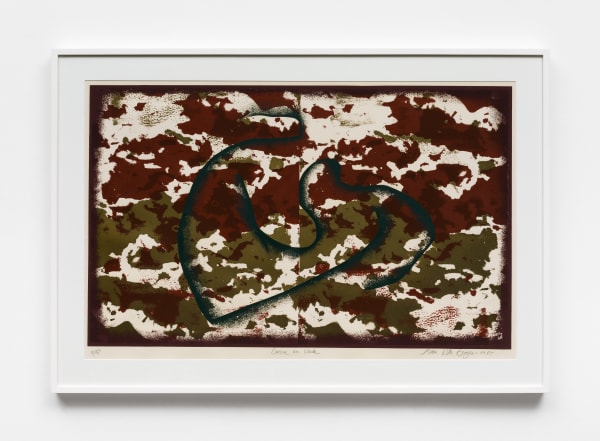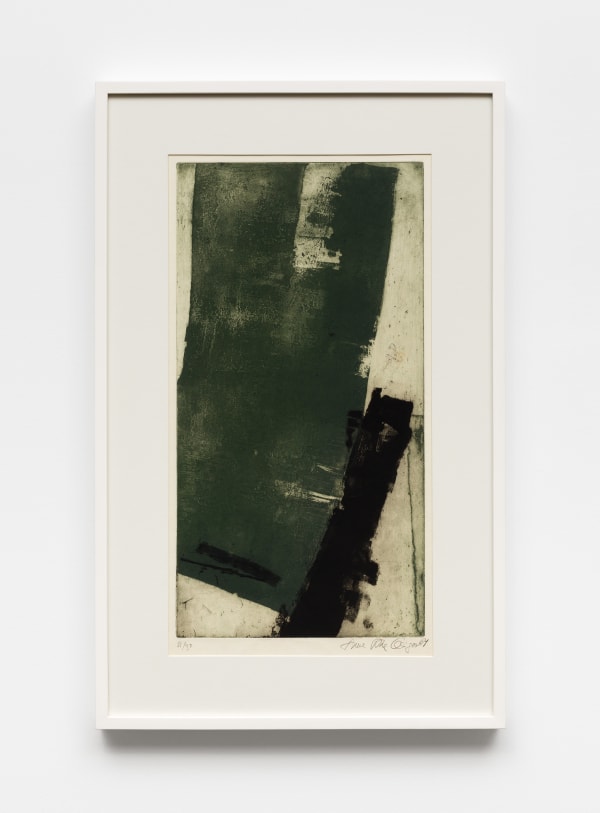quase mapa, quase mancha Anna Bella Geiger
Click here to open the exhibition map
quase mapa, quase mancha
[almost map, almost stain]
Anna Bella Geiger’s oeuvre is vast. It is a body of work permeated by pioneering processes and experiences in the field of art that have led the way, building and consolidating powerful artistic poetics over 75 years.
Quase mapa, quase mancha [Almost Map, Almost Stain] focuses on a daring and little-publicized period within her production developed in the 1980s, which includes works in the media of painting, engraving, and video installation, the latter originally presented at the 16th Bienal de São Paulo in 1981. Historically, this decade is marked in art by a return to painting, which was the hallmark of a generation and was driven by the ideology of the construction of a new concept of the nation after the long years of military dictatorship in the country.
In this period, her work is precisely situated in a fascinating fluctuation between the idea of form and another meaning of representation. This can be seen in the presence of elements in her compositions, often incomprehensible, which play with the relationship between figuration in its most tenuous form, bordering on its absence, a kind of “half map, half camouflage non-place”¹. The video installation that opens the exhibition already raises these questions: titled Mesa, friso e vídeo macios [Soft Table, Frieze, and Video] (1981), it is a variant of the artist’s previous work, O Pão Nosso de cada dia [Our Daily Bread] (1980), at the 39th Venice Biennale. Conceived with similar elements, it was developed for the so-called Bienal da Abertura [Opening Biennial], as the 16th Bienal de São Paulo became known, after the military dictatorship and the boycott that artists – including Geiger – had carried out since 1969 against Institutional Act No. 5 (AI-5), which strengthened censorship in Brazil.
In her installation works, the artist introduces the idea of using upholstery in her production, where we can glimpse a kind of indecipherable territory through the stains and camouflage used in the composition of its surface. We find ourselves in a monothematic space where friezes, tables, and videos are represented by the same pattern of silkscreened and painted shapes on the fabric. We also see silhouettes of clouds, which the artist has transformed into silkscreen clichés, previously used in series of prints and drawings from the 1970s, reflecting on another type of territory that could be freely occupied, or dreamed of being freely occupied, in that historical period, when Brazil was under strong political repression.
Anna Bella Geiger’s work has a history of its own, it speaks for itself and feeds back into experimentation with mediums, elements, materials, and even topics of inquiry. Geiger experienced modern art and its transition to contemporary art in Brazil. She became interested in art at a very young age, at 16 years old, and began her abstract training in engraving and drawing at the studio of Fayga Ostrower in Rio de Janeiro. She lived there with Lygia Pape and Décio Vieira, who also became abstract artists in the 1950s. The artist has a complete body of work that has not lost its essence or inventiveness but has strengthened its experimental character over time, and the installation aspect of her work in this exhibition will penetrate the foundations of her production in this period while inaugurating the space of three-dimensionality in a unique and punctual way.
Mesa, friso e vídeo macios (1981) creates the atmosphere of a “secret chamber” similar to Hollywood noir films, with its low lighting, friezes that refer to architectural elements from another era in a sinuous territory that can be observed when looking at this table from above, as if it were necessary to create a strategy, with suspense hanging in the air. The videos, on the other hand, are nothing more than records of these camouflages that give body to the other elements, filmed from one side to the other in a close and sinuous way, shaking the camera, taking short breaks, going back and forth in rhythmic movements, with disturbing and unintelligible sounds that remind us of a battlefield as seen from above by an airplane or a satellite. The space puts us, or, rather, provokes us into a state of suspension in which the whole scene produced by the patterns still revolves in the suggestion that they present themselves almost as a map or almost as a stain.
The same will be repeated in other works in the exhibition, such as Nuvens I and Nuvens II (Clouds I & II), from 1978, when she was beginning to develop what would become her iconic Macios series – a series of upholstered canvas works mounted on frames of various formats that lose the notion of the vertical and horizontal of traditional canvases – characterizing her first experiments developed in a mixture of silkscreen and the use of painting simultaneously on canvas. The need for “speculative, unsettling painting that has reflections of experimentation” ² as a means of production was noticeable among Brazilian artists throughout the 1980s, and Geiger was no different. Since then, the artist has developed a series of paintings in acrylic and oil on canvas and macios (soft surfaces).
In her paintings, macios, and prints, we can see an aesthetic and chromatic compositional relationship that involves fragmentation to arrive at the whole, the use of stains, camouflage, the overlapping of layers, colors, textures, and volumes, both through the brushstrokes on the canvases and the graphic printing on the prints, which establishes a different perception of abstraction in her work. A production that takes place in “chunks” because if we look at some of the paintings, such as Pier & Ocean III (1985) and Dilúvio [Deluge] (1987), it becomes clear that the artist has faced the blank canvas by dividing it, creating sections within its own surface to develop them or even “solve” them one by one, part by part, culminating in the whole that is presented to us. An attempt to put the fragments in order and question how they fit together in their entirety ³, as the American art critic Dore Ashton would say.
The dilution of the idea of figuration hovers over this proposed selection of works. While there is no abstraction in the traditional sense, there is also no geographical representation, which she continued to explore in her work throughout the 1970s. The works presented here are not based on the guiding principles of her prolific and pioneering work in the so-called Geometric and Informal Abstractionism of the Brazilian avant-garde, which she was able to develop at a very young age in the 1950s and 1960s. Therefore, her composition is based on a different assumption, one that equates both her formal and narrative sides. It is precisely the collision with the pictorial construction of the work in forms, masses of color, and proportions that are thought in an analytical and sectional way, inviting the viewer to observe the work as a whole.
– Ana Hortides
_____________
¹ CHIARELLI, Tadeu. Fax para Anna Bella Geiger. In: Anna Bella Geiger: territórios, passagens, situações. Rio de Janeiro: Casa da Palavra, 2007. p. 165-166.
² NAVAS, Adolfo Montejo. As aporias da pintura (ou uma pintura de pinturas). In: Anna Bella Geiger: territórios, passagens, situações. Rio de Janeiro: Casa da Palavra, 2007. págs. 30-34.
³ ASHTON, Dore. Anna Bella Geiger. Review: Latin American Literature and Arts, n.48, 1984.
Painting, paintings.
The painting from those years was done from an absolute refusal within some kind of conceptual thought. However, some artists guided by those issues started to appear abroad. When I looked at some of their paintings, I understood that for them, was the same as it was for me. It was from a different nature.
The expression “Return to painting”, in 1980s Rio de Janeiro, didn’t mean any of what I was dealing with in my work. It was not my return to painting either, in the sense of the abstract oils from the 1950s. This painting was neither abstract nor figurative. What was it, then?
My way of organizing the canvas, which I presented in exhibitions in the Saramenha and São Paulo galleries and in various Biennales, was different. Recently, while I was taking part in an exhibition in Madrid, curator Tiago de Abreu Pinto said that the piece was seen as abstract in Spain. It’s not that I was thinking of doing another painting – it’s more that it presented elements unknown even to myself, elements which I understand are conceptual both in their nature and meaning. It arose from the idea as an idea. This did not prevent me from using means or categories such as painting, but there were no artists working in this manner here during the 1980s, or even during the 1990s, for that matter.
Strangely, when I started the series of paintings called Pier and Ocean, I was completely stunned by Vermeer’s painting. He belonged to the North Dutch Baroque, which is not religious. I was starting to understand his paintings through their architectural construction, not their figurative and descriptive elements. I imparted those elements from houses and streets, from their entrances and interiors, eliminating the human figure in his work. What interested me in this artist’s and his contemporaries Jan Steen’s and De Hooch’s street scenes were the structures’ stylistic characteristics, which was like a composition, the tridimensional aspect of the façades and of the internal corridors. This different angle that they used, which intercepts a right angle, directs the gaze of the spectator inside the building. There is this visual manipulation of the real.
I’ve also imparted to my compositions the use of light – a symbolic light, typical of 18th century Dutch Baroque. In Vermeer’s work, there are abrupt variations between light and shadow where the orthogonal use of the windows’ frames and of the perpendicular tables work as obstacles to the entrance of the space created on the canvas. Although one thinks of “composition” as an ancient word, it is not. What is in fact ancient is the way you balance the whole, an essential issue for any artist since the Renaissance.
I came in through there and started to build the painting bit by bit, which already isn’t a matter of abstraction. In Abstractionism the whole space on the canvas must be occupied – it is upon its area that balanced and unbalanced situations will be created.
In my case, however, the contrary was true: I built my paintings’ foundations from left to right, dividing them. I don’t refer to Vermeer’s figuration, but to his composition, his structure. And I was so immersed in that, that this series of paintings, Pier and Ocean, was created from Mondrian’s title in his work. He gave these titles to his works with the intention of saying this: when he names something Pier, he names the construction of the structure, which is probably what I look for in Vermeer’s paintings – his Piers. And Ocean is the substance of painting itself.
I claimed this title to understand the way of constructing, which was never connected to Geometric Abstractionism, although I studied the beginning of its formation. The work, however, embarked on the issue related to the Informal or Lyrical. One can see that in the abstract engravings from the 1960s, as well as in the paintings on show here. I was so convinced of this discovery that it is... The artist is possessed by an idea that is her fortune. So, how will she develop this idea? I did not know that. But this was a time when I painted bigger and bigger paintings. Some were 2m tall, which I showed in various exhibitions and Biennales.
Those who see a painting like mine can perceive several layers of meaning. Conceptual works establish situations unrelated to an obvious visuality and are neither images for images’ sake. They contain no secret I want to reveal. They occur within a specific situation in the composition, in the very elements to which I refer.
Mondrian’s Pier and Ocean only exists because Vermeer existed.
My Pier and Ocean were guided by the same logic.
— Anna Bella Geiger
-
 Anna Bella Geiger, EW 18 com tendência neo-concreta, 1981
Anna Bella Geiger, EW 18 com tendência neo-concreta, 1981 -
 Anna Bella Geiger, MESA, FRISO E VIDEO MACIOS, 1981
Anna Bella Geiger, MESA, FRISO E VIDEO MACIOS, 1981 -
 Anna Bella Geiger, Nuvens I, Macios series | Nuvens I, série Macios, 1978
Anna Bella Geiger, Nuvens I, Macios series | Nuvens I, série Macios, 1978 -
 Anna Bella Geiger, Nuvens II, Macios series | Nuvens II, série Macios, 1978
Anna Bella Geiger, Nuvens II, Macios series | Nuvens II, série Macios, 1978 -
 Anna Bella Geiger, ...Equilíbrios instáveis, Macios series | ...Equilíbrios instáveis, série Macios, 1987
Anna Bella Geiger, ...Equilíbrios instáveis, Macios series | ...Equilíbrios instáveis, série Macios, 1987 -
 Anna Bella Geiger, Pier & Ocean cor rosa, 1986
Anna Bella Geiger, Pier & Ocean cor rosa, 1986 -
 Anna Bella Geiger, Pier & Ocean III, 1985
Anna Bella Geiger, Pier & Ocean III, 1985 -
 Anna Bella Geiger, MAVERKK, 1985
Anna Bella Geiger, MAVERKK, 1985 -
 Anna Bella Geiger, Dilúvio, 1987
Anna Bella Geiger, Dilúvio, 1987 -
 Anna Bella Geiger, Cais e Oceano n°5, 1985
Anna Bella Geiger, Cais e Oceano n°5, 1985 -
 Anna Bella Geiger, N.2 Magenta Platz, 1984
Anna Bella Geiger, N.2 Magenta Platz, 1984 -
 Anna Bella Geiger, Blau Platz, 1984
Anna Bella Geiger, Blau Platz, 1984 -
 Anna Bella Geiger, N.25 Curva em verde, 1985
Anna Bella Geiger, N.25 Curva em verde, 1985 -
 Anna Bella Geiger, N.26, 1985
Anna Bella Geiger, N.26, 1985 -
 Anna Bella Geiger, Untitled | Sem título, 1964
Anna Bella Geiger, Untitled | Sem título, 1964 -
 Anna Bella Geiger, Untitled | Sem título, 1965
Anna Bella Geiger, Untitled | Sem título, 1965 -
 Anna Bella Geiger, Untitled | Sem título, 1964
Anna Bella Geiger, Untitled | Sem título, 1964 -
 Anna Bella Geiger, Do amor ao bocado azul, 1966
Anna Bella Geiger, Do amor ao bocado azul, 1966 -
 Anna Bella Geiger, Untitled | Sem título, 1981
Anna Bella Geiger, Untitled | Sem título, 1981 -
 Anna Bella Geiger, Untitled | Sem título, 1962
Anna Bella Geiger, Untitled | Sem título, 1962






















